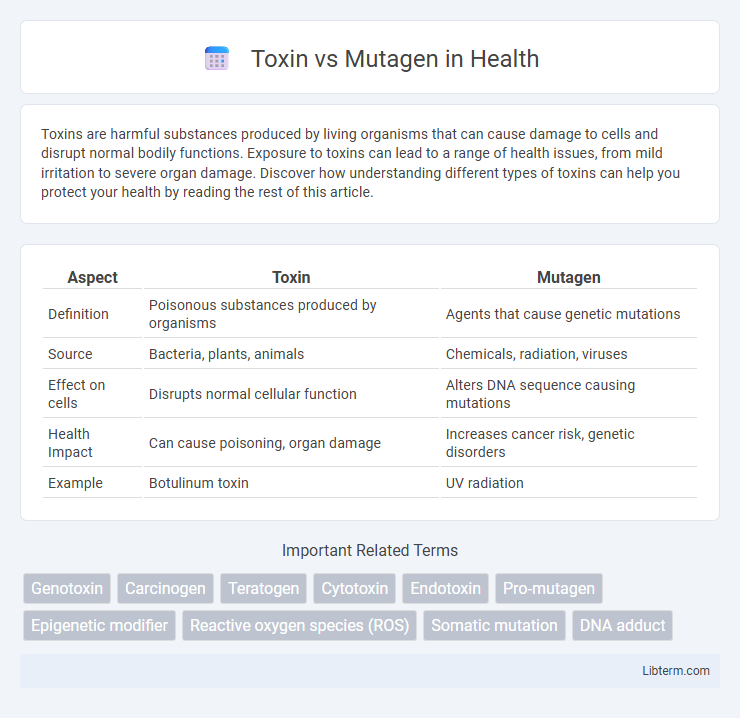Toxins are harmful substances produced by living organisms that can cause damage to cells and disrupt normal bodily functions. Exposure to toxins can lead to a range of health issues, from mild irritation to severe organ damage. Discover how understanding different types of toxins can help you protect your health by reading the rest of this article.
Table of Comparison
| Aspect | Toxin | Mutagen |
|---|---|---|
| Definition | Poisonous substances produced by organisms | Agents that cause genetic mutations |
| Source | Bacteria, plants, animals | Chemicals, radiation, viruses |
| Effect on cells | Disrupts normal cellular function | Alters DNA sequence causing mutations |
| Health Impact | Can cause poisoning, organ damage | Increases cancer risk, genetic disorders |
| Example | Botulinum toxin | UV radiation |
Introduction to Toxins and Mutagens
Toxins are poisonous substances produced naturally by living organisms such as bacteria, plants, or animals, causing harm to other organisms upon exposure. Mutagens are agents, which can be chemical, physical, or biological, that induce genetic mutations by altering the DNA sequence within cells. Both toxins and mutagens impact biological systems, but while toxins primarily cause immediate toxic effects, mutagens specifically alter genetic material, potentially leading to cancer or hereditary diseases.
Defining Toxins: Nature and Sources
Toxins are poisonous substances produced naturally by living organisms such as plants, animals, and microorganisms, and they can cause harm when introduced into the body. These biological toxins include venom from snakes, bacterial endotoxins, and plant alkaloids, each varying in their mechanisms of action and target tissues. Understanding the nature and sources of toxins is essential for identifying exposure risks and developing appropriate medical treatments.
Defining Mutagens: Types and Mechanisms
Mutagens are agents that cause changes or mutations in the DNA sequence, leading to genetic alterations that can result in cancer or hereditary diseases. Types of mutagens include chemical mutagens, such as alkylating agents and base analogs, physical mutagens like ultraviolet and ionizing radiation, and biological mutagens from certain viruses and transposons. These mutagens operate through mechanisms such as base substitution, frameshift mutations, DNA cross-linking, and strand breaks that disrupt the normal replication and transcription processes.
Key Differences Between Toxins and Mutagens
Toxins are poisonous substances produced by living organisms that cause harm by interfering with normal biological functions, while mutagens are agents--chemical or physical--that induce genetic mutations by altering DNA sequences. Unlike toxins, which primarily disrupt physiological processes, mutagens specifically target the genetic material, leading to potential hereditary changes and increased cancer risk. Understanding these distinctions is crucial for assessing environmental hazards and developing appropriate safety measures in toxicology and genetics.
How Toxins Affect Biological Systems
Toxins disrupt biological systems by interfering with cellular processes such as enzyme function, membrane integrity, and signal transduction pathways, leading to cell damage or death. They can accumulate in tissues and provoke immune responses, inflammation, or oxidative stress, compromising organ function. Unlike mutagens that specifically alter DNA sequences, toxins exert their harmful effects through biochemical interactions at the molecular and cellular levels.
Genetic Impact of Mutagens
Mutagens directly alter the DNA sequence by causing mutations, which can lead to genetic disorders, cancer, and hereditary changes across generations. Unlike toxins, which may damage cells or organs without altering genetic material, mutagens specifically interact with the genome, resulting in base substitutions, insertions, deletions, or chromosomal rearrangements. The genetic impact of mutagens is crucial in studies of carcinogenesis, genetic diseases, and evolutionary biology.
Common Examples of Toxins and Mutagens
Common toxins include substances such as botulinum toxin, produced by Clostridium botulinum, and aflatoxins, which are toxic metabolites from Aspergillus fungi. Mutagens commonly consist of chemicals like benzopyrene found in tobacco smoke and ultraviolet radiation from sunlight, both known to cause DNA mutations. Understanding these examples highlights the significant health risks posed by toxins disrupting cellular function and mutagens altering genetic material.
Environmental Exposure and Health Risks
Environmental exposure to toxins, such as heavy metals and pesticides, can cause immediate or chronic health effects by disrupting biological functions. Mutagens, including UV radiation and certain chemical agents, induce genetic mutations that increase the risk of cancer and hereditary diseases. Both toxins and mutagens contribute significantly to disease burden through contamination of air, water, and soil in industrial and urban areas.
Detection and Prevention Strategies
Detection of toxins involves biochemical assays such as ELISA and mass spectrometry, whereas mutagen detection often employs Ames test and comet assay to identify DNA damage. Prevention strategies for toxins include proper handling, storage, and use of personal protective equipment, while mutagen prevention emphasizes minimizing exposure to radiation and chemical mutagens through environmental controls and regulatory limits. Integrating advanced biosensors and genetic screening enhances early detection and effective risk mitigation for both toxins and mutagens.
Conclusion: Implications for Human Health
Toxins and mutagens pose distinct but overlapping threats to human health, with toxins primarily causing immediate physiological damage and mutagens inducing genetic alterations that may lead to cancer or hereditary diseases. Understanding the specific mechanisms of toxicity and mutation enables targeted prevention strategies and risk assessments to minimize exposure in occupational and environmental settings. Effective regulation and public awareness are essential to reduce long-term health impacts from both toxic substances and mutagenic agents.
Toxin Infographic

 libterm.com
libterm.com